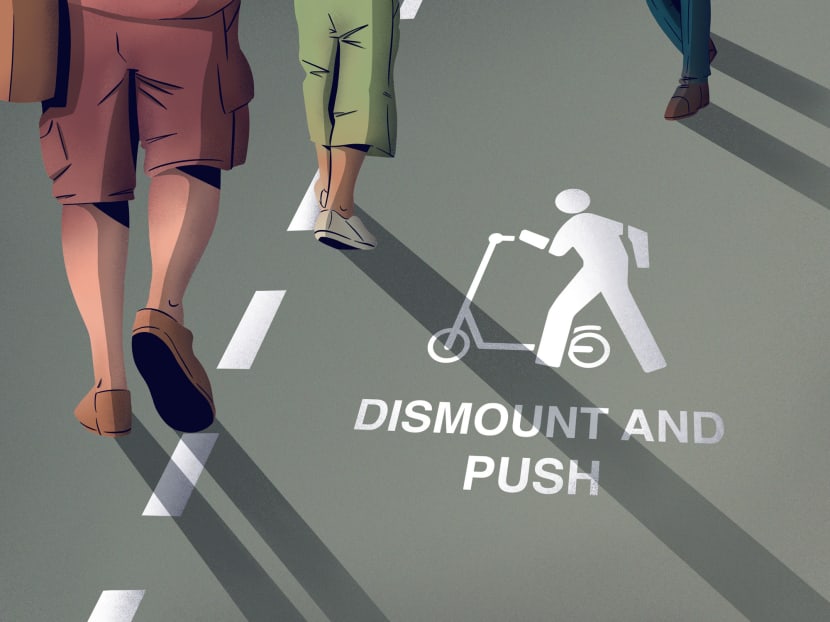The Big Read in short: Life after the e-scooter footpath ban
Each week, TODAY’s long-running Big Read series delves into the trends and issues that matter. This week, we look at the effects on different groups, following the ban of e-scooters from footpaths which drew strong public reactions earlier this month. This is a shortened version of the feature.

Many pedestrians gave the thumbs up for the ban while e-scooter users were wringing their hands over the loss of a convenient and cheap means of transport — and a potential big drop in earnings for food delivery riders.
Each week, TODAY’s long-running Big Read series delves into the trends and issues that matter. This week, we look at the effects on different groups, following the ban of e-scooters from footpaths which drew strong public reactions earlier this month. This is a shortened version of the feature, which can be found here.
SINGAPORE — Like a bolt from the blue, the Nov 4 announcement by the Government that electric scooters would be banned from footpaths the very next day caught many people off guard. A ban on other personal mobility devices (PMDs) will be rolled out progressively by the first quarter of next year.
Many pedestrians gave the thumbs up for the ban while e-scooter users were wringing their hands over the loss of a convenient and cheap means of transport — and a potential big drop in earnings for food delivery riders.
In the immediate aftermath, scores of food delivery riders turned up at the meet-the-people and dialogue sessions held by Members of Parliament to vent their frustrations and unhappiness.
To allay their anxiety, the Government, along with three major food delivery firms, announced a S$7 million e-scooter trade-in grant to help food delivery riders switch to other vehicles.
For PMD retailers, the impact has been swift and heavy: Sales of e-scooters have plunged to zero for some of them in recent weeks, as they mull over ways to get rid of their stockpiles.
For others such as pedestrians, food delivery riders and people who use PMDs for daily commute, they are still adjusting to life after the ban.
PEDESTRIANS
These days, 58-year-old Loy Chit See no longer feels bothered or stressed when he takes his children out for walks at the weekend. The same could not be said before the ban, when e-scooters could be seen everywhere in his Serangoon estate.
“I nearly got knocked down once, the guy just sped past and I couldn't believe it,” said the father of two children aged seven and ten. “The stress becomes high … When I walk (my children) to NEX (shopping mall), I have to be extra careful.”
After the ban, Mr Loy said the number of e-scooters he sees in his neighbourhood has dropped significantly.
Like Mr Loy, many of the 16 pedestrians whom TODAY spoke to across e-scooter “hotspots” such as Punggol, Choa Chu Kang, Yishun and Serangoon, welcome the ban.
Punggol resident Ng Cheow Yong, 76, said e-scooters in his estate typically move at frightening speeds. As he walks while running errands, he worries that given his advanced age, he will be unable to react when an e-scooter approaches from behind.
Mr Ng said that he is less stressed now that there are fewer e-scooters. He sees about one or two on his walks, unlike before when about five or six riders would speed past him.
When asked if he thought food delivery riders were having it tough, Mr Ng disagreed. “It’s fair that these food delivery riders have to find alternative arrangements, as long as the pedestrians are kept safe. If they were to continue riding, then where should we walk?”
Still, some felt that a ban was too drastic a step and pedestrians have a part to play too.
Punggol resident Carene Law, who has three children aged 3 to 9 years old, saw it as her own responsibility to keep her kids safe.
“It is my responsibility to take care of my kids. I will ask my kids to just look around, when you see anything just keep to one side,” Ms Law said.
FOOD DELIVERY RIDERS
As early as February, 34-year-old Muhammad Imran had seen the writing on the wall. At that time, there had been an increase in accidents involving PMDs on footpaths, and calls of a ban were growing louder.
The part-time food delivery rider thus decided to switch to riding a bicycle. But for Mr Imran, who was obese at that time and weighed 120kg, it was difficult to adjust initially.
“When I first started, I would only do two orders, and then I would be extremely (tired)... I was not fit at all.” Back then, he would only earn about S$10 a day before throwing in the towel.
Things only started to improve after he had cycled for four to five months. Today, Mr Imran is able to deliver 25 orders a day on his bicycle, and is earning as much as when he was riding his e-scooter — about S$130 a day. He has also gotten fitter, having lost more than 30kg.
He reckoned that it would take an average e-scooter rider about three months to get used to the new mode of transport.
“Riders should give themselves some time, and think of it as a way to increase your fitness and also to help you to be (healthier compared) to those who are just riding around on e-scooters.”
However, among the 11 food delivery riders whom TODAY spoke to, most bemoaned the lack of time to adjust to the new situation due to the suddenness of the ban.
With the ban, e-scooters are now confined to bicycle tracks, paths shared by pedestrians and cyclists, and park connectors. Electric bicycles, however, may be used on roads, while bicycles are allowed on footpaths and roads.
Riders who had switched to riding bicycles generally said their earnings had dropped by about half.
Part-time delivery rider Cindy Goh, who is in her 30s, said most of her deliveries require her to ride for about 2 to 3km. Once, she had to cycle for more than 4km.
Ms Goh, who does deliveries around Jurong Point shopping mall, said she often had to cancel orders from the Nanyang Technological University, due to the distant proximity and high slopes on the campus grounds. She used to be able to deliver to those areas on her e-scooter.
While Ms Goh used to deliver more than 10 orders a day on her e-scooter and earned about S$50, she can only do half the amount on her bicycle, and earns about S$25.
For riders who have stuck to using their e-scooters, their earnings have also taken a hit.
Ms Sarah Alatas, 22, said she now makes it a point to take longer routes that have park connectors or bicycle paths. She would dismount and push her e-scooter on footpaths. If the delivery route comprises primarily of footpaths, she would decline the order.
A full-time food delivery rider who only wanted to be known as Ms Ikah said she has stopped using her e-scooter to do deliveries in the day. However, she continues to flout the ban at night in the hope that there is less chance of her getting caught.
“I normally start (making deliveries) after 7pm, and work until the last order at 2am,” said the 29-year-old, who is a single mother supporting three young children.
By doing this, her working hours have shortened and while she used to earn S$70 a day, she is now making half the amount.
She acknowledges that the current situation is untenable. Come January, she will be looking for a new job. “A part-time job, any day job will do,” she said.
HOW OTHER E-SCOOTER USERS ARE ADAPTING
For Mr Mohammad Subhan, the ride from his Pasir Ris home to his workplace at Marina South Pier used to take one hour with an e-scooter. His route to work — which he estimates to consist of footpaths for about a third of the journey, with the rest being either park connectors or bicycle paths — has taken half an hour longer since the ban.
The part-time operations manager of a boat charter service now either slows down when he rides on footpaths, or dismounts his e-scooter to push it.
The 47-year-old does not mind the hassle since he could save a few dollars on public transport daily.
For Mr Mohammad Fadil, a technical officer at SMRT’s Kim Chuan Depot, his commute from his Bedok Reservoir home to his workplace at Tai Seng takes him about 45 minutes by bus. This is 15 minutes slower than when he travels by e-scooter.
Following the ban, the 37-year-old now skips his usual breakfast and lunch haunts, which he would stop by previously on his way to work riding his e-scooter. In the past few weeks, he has been having his meals at his workplace canteen instead.
For those working in less accessible locations, e-scooters used to be a convenient way to avoid the squeeze in feeder buses.
Mr Mahadi Md Johari, a housekeeper at a nursing home, previously rode his e-scooter from his Circuit Road home to his workplace at Serangoon Gardens.
Now, he takes a bus from his home, before switching to a feeder bus. A trip that used to take about 25 minutes by e-scooter now takes almost twice as long. He also has to fork out S$3.50 a day in transport fares to get to work.
Mr Mahadi lamented that the actions of some black sheep have caused the authorities to enact a ban — to the chagrin of responsible users. “Now everyone has to pay for it,” he said.








